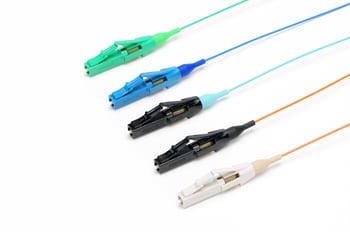Once you've made your fiber cable selections, optical termination footprint and termination method come next. Many termination methods exist each having their own benefit and value. Corning will help make that selection and has a solution that fits any user requirement.
Optical termination footprint can be broken down into two major categories: single-fiber connectors and multi-fiber connectors.
Most commonly found single-fiber connectors:
- SC – commonly deployed push-pull connector deployed in all application spaces
- LC – rapidly becoming the most common used connector footprint as it doubles the density of a SC connector and is most commonly found duplexed at connector interfaces
- ST – legacy connector footprint using a push and twist latching mechanism and is commonly found in low-density harsh environment applications
Multi-fiber connector:
- MPO or Corning’s MTP Connector is a multi-fiber array connector typically found in data center applications where maximum density is desired. Limited field-termination methods exist today for this footprint.
- Connector bodies are typically colored to designate fiber type and performance. Please refer to the table below.
| Connector Color | Fiber Type/Performance |
| Beige | OM1 (62.5 µm) |
| Black | OM2 (50µm) |
| Aqua | OM3 (50µm) |
| Blue | OS2 (Single mode) |
| Green | OS2 (Single mode angled polish) |
Note* - Corning recommends matching fiber, connector, and adapter type for performance and identification purposes.

When choosing termination method, several factors must be considered:
- Skill level of the installer
- Cost of termination
- Quality and performance
- Speed of deployment
| Method | Ease of Use | Cost | Performance |
| Epoxy & Polish | Low | Low | Moderate |
| No epoxy, No polish | High | High | High |
| Fusion Spliced | Highest | Highest | Highest |
Corning has a solution for each.


.png?width=58&height=58&name=X_logo_2023_(white).png)
